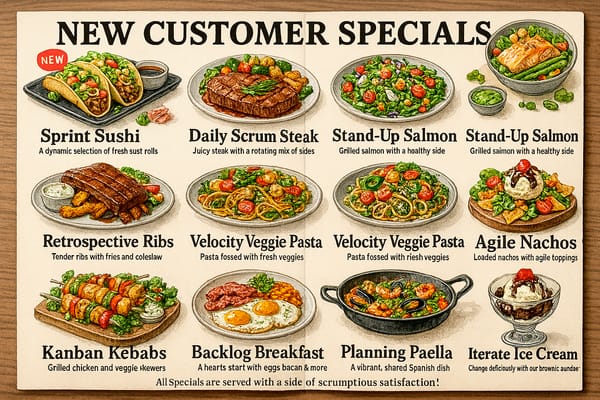Sales-aligned delivery: Ending the agency feast-or-famine cycle
A practical guide to aligning sales and delivery so your agency grows with purpose.

It’s a familiar pattern. There’s either too much work to do, or there’s not enough.
One month your team are scrabbling to hit deadlines, and everyone is jumping between high-profile projects. The next they’re sat twiddling their thumbs, moving your website logo 3 pixels to the left, or rewriting the internal comms guides for the sixth time.
You either have half the team asking what they should be doing with their free time, or everybody wondering when you’ll hire to support the capacity challenges.
The bottom line swings like a pendulum between champagne months and future-questioning ones. The stress is real, but there are alternatives.
Feast or famine
This is feast or famine, and one source is having a disconnect between your sales function and your delivery team.
In small businesses this can be caused by the same people both selling and delivering. The focus can only be on one at a time.
So why do I see it so often in well established agencies, where sales and delivery have their own teams?
Sales incentives
How should we measure the success of our sales teams?
What behaviour and outcomes should be celebrated when it comes to the people bringing in new business?
Potential revenue? Conversion rate? Sales revenue? Sales teams are often measured on financial numbers and success rates. Obviously.
But if the focus is on financial targets, what does that mean for our ability to deliver the work?
Common project pains come in many forms.
Underpriced challenges
Where the work required isn’t realistically covered by the budget (or time) available. This may come to light at any point in a project.
Large single-phase commitments
When a very long running project with a large budget and complex commitments lands. Larger always means more unknowns and a gap for accurately costing.
Clients lacking alignment
It’s important to work with the right clients. They should understand your value, have overlaps in culture and approach, understand how complex their needs are.
Highly custom requirements
Selling a completely new solution to every client is a delivery and support nightmare.
Disconnected Sales
When delivery and sales aren’t in sync, it’s rarely invisible. The situation manifests in an agency in various ways.
- Profit volatility – overtime, freelancer searches and idle salary burn.
- Team fatigue & churn – burnout, lower morale and even churn.
- Quality slip & rework – failures, bugs and scope seep (over-delivery).
- Client trust erosion – missed deadlines, long response times, client churn.
- Strategic drift – leadership firefighting over future planning.
Whether it always feels too busy, or you regularly swing between feast and famine, it costs far more than cash. It drains your people, reputation, and potential for growth.
Joined-up Sales
One powerful alternative is for sales to become a cross-functional effort.
The sales specialists still lead discussions and alignment and financials, but they aren’t flying solo for so long.
Early involvement of other teams can help ensure a focus on the right work at the right time from the right clients.
Sales Roles
That involvement doesn’t have to be ownerous, and can be justified as an explicit front-loading of the understanding work which is required in every project.
- Delivery – advise on risk, relevant experience, capacity, timelines and phasing
- Support - advise on maintenance, security, value delivery and stability
- QA - advise on scale of testing, integrations and approach to quality
All this input helps with a shared judgement of the suitability of the client, and the project. It may help guide the budget required, the timeline and what an ongoing relationship might look like.
Everybody works to surface the definition of value, and align around what success looks like both now and in the future.
Guidelines
A simple set of Must, Should, Could and Won’t (or MoSCoW) criteria ensures no wildcard projects swallow too much time or energy.
The criteria ensure people understand exactly how aligned the work and client are with your agency’s positioning.
If an example scoring matrix would help here, let me know in the comments.
Alternative incentives
And the criteria become a great basis for measuring sales success.
- How well is the pipeline aligned to the agency?
- How many clients have roadmaps beyond the current project?
- What percentage of new client work uses tools or techniques the agency has experience with?
- Is the pipeline prioritised with current capacity in mind?
- Are new projects making good use of the available delivery team?
- Is the delivery flexible?
- Are scope (spec vs outcomes), timeline or budget up for discussion and review?
And of course
- How much money are those projects going to bring through the door?
Thanks for reading this far! Subscribe for free to receive new posts and support us.
Sales-Aligned Delivery in Practice
Turning the principles above into a calm, predictable delivery approach hinges on three interconnected habits.
Transparent forecasting, not a spreadsheet graveyard
Pull every qualified opportunity into a single, living board.
Attach a probability to close, likely kick-off date and budgeted hours for each.
Update these fields the moment the deal moves stages.
Run a 30-minute “pipeline × capacity” huddle every week
Sales walks through changes in deal probability, size and timing.
Delivery reacts by confirming which roles are free, stretched or unavailable.
Together you decide: retime, re-scope, re-price or pause each deal.
Publish a simple traffic-light report update after each huddle
Green – fits capacity, skills and strategic criteria. Low risk. No concerns.
Amber – fits if something else shifts (freelancer, holiday clash, phased scope).
Red – mis-aligned or impossible without jeopardising other work.
Share it all with the team and senior leadership, with finance and project leads. Ensure everyone sees the same reality.
By institutionalising these habits you transform the MoSCoW guidelines from a theoretical gate into a weekly calibration tool. One that steadily nudges both pipeline and production toward the same goal: profitable, repeatable work.
Metrics that show progress
Some potential ways - both leading and lagging - to measure the improvements.
These are just examples. The numbers should be specific to your own context.
Stable utilisation - ≤ 20 % variance between forecast & actual hours per role or 3-month rolling average billable utilisation within target band
Healthier margins - < 10 % average discount between quoted & delivered effort or Gross margin per project meets or exceeds target
Happier humans - Weekly team pulse: “I have the right amount of work” ≥ 70 % positive or Annual staff turnover below industry benchmark
Stickier clients - % of new deals that include a phase two/roadmap/retainer ≥ 60 % or 12-month client retention rate rises year-on-year
Track the leading indicators in your weekly huddle; celebrate the lagging wins in quarterly retros. When the lead metrics wobble, you can catch feast-or-famine patterns months before they hurt morale or cashflow.
From theory to flywheel
Change is hard. Moving between approaches is always best done slowly.
- Start small. Pilot the huddle with one delivery workflow/team/pod and a sales lead.
- Automate the boring bits. Flag up, and automate workflows which cut manual admin. (Some) email chains, data changes, reporting, setup.
- Retro ruthlessly. At least each quarter, ask the group: Which part of the loop felt heavy? Which metric felt pointless? Where did clients struggle? Trim and tweak.
- Scale deliberately. As confidence grows, fold in support, QA and finance, then open the process to other areas.
Within a few cycles you’ll notice the rhythm: sales pitches only work you can actually deliver; delivery teams see what’s coming and can shape projects early; finance watches margin stabilise; leadership stops firefighting.
The payoff
When sales and delivery plan capacity together, feast or famine gives way to a sustainable cadence:
- Predictable revenue instead of champagne-and-dry-toast months.
- Engaged teams who can focus on craft, not chaos.
- Clients for life who feel the steadiness in every interaction.
- Commercial awareness where once there was apathy.
- Team buy-in and excitement about challenges and potential.
That’s the real promise of sales-aligned delivery: an agency that grows on purpose - one confident yes at a time.
Thanks for reading! Subscribe for free to receive new posts and support us.
Ready to calm the chaos?
If smoothing out feast-or-famine cycles sounds good in theory but tricky in practice, helps agencies put these habits in place. Helping the pipeline, the people and the profit line all move in step. Get in touch.
Header photo by Tomas Sobek on Unsplash




